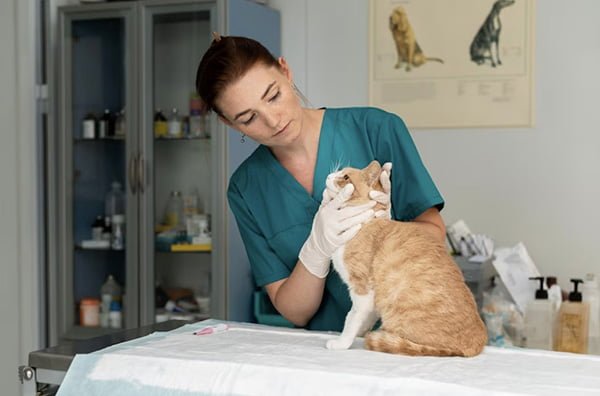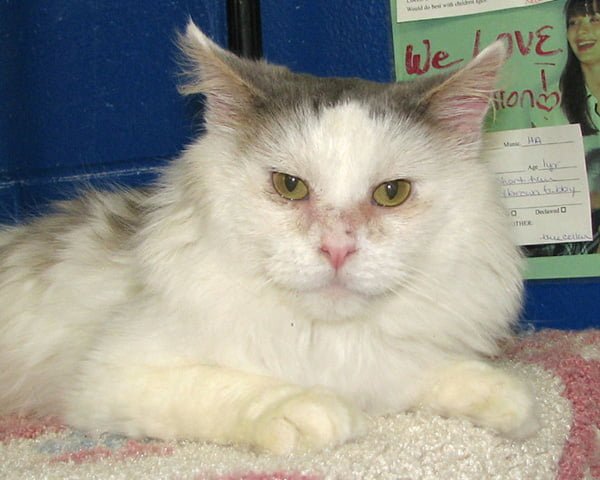You've likely heard of the feline herpes virus and may wonder how it can affect your furry family member. While highly contagious among cats, feline herpesvirus (FHV, FHV-1, FVR) cannot spread to people or other animals. But there are some similarities, including that the virus can remain dormant in the body and recur in times of stress, leading infected cats to become chronic carriers. Studies show that over 97% of cats have been exposed to herpes, so here's what pet parents should know about these common eyes and upper respiratory infections.
What is Feline Herpesvirus
Feline viral rhinotracheitis (herpesvirus-1) is a highly contagious viral infection that is associated with upper respiratory symptoms in cats. It is also the most common cause of conjunctivitis (inflammation of tissues surrounding the eye) in cats. In most cases, clinical signs begin 2-5 days after exposure and last for 10-20 days. However, after initial infection, the virus will lie dormant in the body for long periods and can cause a recurrence of symptoms, usually in times of stress.
Symptoms of Feline Herpesvirus
The feline herpes virus causes typical signs of upper respiratory infection, including:
Nasal discharge and congestion
Sneezing
Conjunctivitis - squinting, redness, inflammation, eye discharge
Keratitis - thick white plaques on the surface of the eye
Cough
Fever
Possible ulceration of the eyes, nose, and mouth
Lethargy
Decreased appetite
While all cats can get feline herpes, kittens, seniors, and cats with chronic illness are more likely to have severe symptoms.
Causes of Feline Herpes
Herpes is highly contagious among cats and is spread via saliva and discharge from the eyes and noses of infected cats. Cats may also become infected by contact with fomites (objects that carry infection), such as food and water bowls, clothing, and furniture. The virus can remain on these objects for up to 18 hours as long as they remain moist, but most secretions will dry out and become inactive within a few hours. Kittens may also be infected after birth if their mother is a carrier.
All cats infected with herpes will be carriers of the virus, and many will experience recurrence of symptoms throughout their lifetime. During these active periods of infection, they will shed viral particles and thus be contagious to other cats. In some cases, cats may be contagious even if they are not showing clinical signs of disease.
All cats are susceptible to herpes. However, young kittens or cats with other underlying medical conditions, including immunocompromised ones, are more likely to experience severe disease and symptoms. Worst-case scenarios can lead to eye rupture and blindness, deformities of the nasal passages, and complications such as secondary infections.

Source: Freepik
How is Feline Herpes Diagnosed
Multiple conditions cause upper respiratory symptoms and conjunctivitis in cats.
A presumptive diagnosis of feline herpesvirus infection is based on the cat's medical history and physical exam. There are also several tests that your vet may recommend to evaluate your cat's eyes further and rule out other issues.
Fluorescein stain - This test checks for the presence of a corneal injury or ulcer. A small amount of stain is applied to the eye, which will stick to areas of ulceration and glow under black light.
Schmear tear test - This test is used to measure tear production. It involves placing the tip of a special filter paper inside the lower eyelid and waiting for 60 seconds.
Tonometry - This test involves gently touching the surface of the eye with a Tonopen to measure pressures within the eye. Intraocular pressure may be elevated in glaucoma or decreased in uveitis.
PCR testing on samples taken from the eyes, nose, and throat may be useful in some cases to diagnose herpes definitively. Specific tests are also available for other common viruses and bacteria that often cause upper respiratory disease.
However, these tests are not always recommended. For one reason, these pathogens are so common that many cats will test positive even if they do not have an active infection. For another, it does not usually change the recommended course of treatment. Additional testing in complex cases should be discussed with your vet.
How is Feline Herpes Treated
There is no cure for the feline herpes virus, as infected cats will remain carriers for life; however, there are successful management strategies for decreasing the severity of clinical signs, reducing secondary complications, and decreasing the frequency of flare-ups.
Treatment usually involves topical antibiotics placed into the eyes(s) to manage conjunctivitis. Depending on the severity and other clinical signs, oral antibiotics or antiviral medications may also be indicated. Nursing care to encourage eating and maintain hydration are also important, especially in sick kittens. In severe cases, if a cat is very lethargic, febrile, or not eating, hospitalization may be required.
Topical antibiotics - To treat secondary eye infections
Antibiotics - Although herpes is a virus, infected cats may get secondary bacterial infections. Therefore, antibiotics may be also used to treat secondary bacterial infections. Commonly used antibiotics include Clavamox, doxycycline, and azithromycin.
Antiviral medications - Ophthalmic and oral medications are available and can help curb viral replication and assist the cat's immune system. Famciclovir was initially developed to treat humans with herpes and has been shown to be extremely effective in cats as well.
Nursing care - Humidification in a steamy bathroom and offering moist/smelly/warmed canned food to help stimulate appetite are often recommended.
Other - probiotics, lysine, and hyaluronate eye drops may also be beneficial
Flare-ups will be managed in much the same way as the initial infection. In some cases, if symptoms are mild, they may resolve on their own.
Recovery and Management of Feline Herpes
In most cases, the initial infection lasts for 10-20 days. However, the virus can lie dormant in the body for long periods and then cause a recurrence of symptoms, usually in times of stress. The following are recommendations if you are dealing with herpes in one or more of your feline friends:
Isolation and decontamination
Cats with active infections will be contagious for up to three weeks, and those who are carriers may always be infectious. Affected cats who appear ill should be isolated from other cats in the household. However, if the other cats are fully vaccinated adults, they may only develop mild and self-limiting symptoms. The virus can easily be killed with a bleach solution, washing clothing and bedding in hot water, or with soap and water.
Prevent exposure
Preventing direct contact between cats and washing your hands after petting other cats will be the best way to keep your furry family members safe. On a similar note, if you have a cat that is positive for herpes, the affected cat should be kept indoors only to avoid exposing other cats.
Vaccination
FVRCP is a core vaccine recommended for all cats and is protective against feline rhinotracheitis (herpes), as well as calicivirus and panleukopenia. However, like most vaccines, it cannot completely prevent disease but aims to decrease the severity and length of illness. This vaccine is generally due every three years after the initial kitten series has been completed.
Stress reduction
Herpesvirus can become reactivated during times of stress. This is unavoidable in many cases, such as moving houses or a baby joining the family. However, there are many ways that you can help decrease stress in your cat's daily life, including making sure that there are enough litter boxes and resources in multi cat homes, providing enrichment for indoor-only cats such as interactive feeding toys, and using products such as Feliway.
Discuss additional supplements or medications with your vet.

Source: Flickr
FAQs
How is feline herpes transmitted?
Herpes is highly contagious in cats and is spread via saliva and discharge from the eyes and nose of infected cats. Cats may also become infected by contact with fomites (objects that carry infection), such as food and water bowls, clothing, and furniture. For these reasons, herpes is commonly seen in environments with multiple cats, such as animal shelters and catteries. Once the initial virus has resolved, it can lie dormant in the body and cause a recurrence of symptoms, especially in times of stress.
Can feline herpes be prevented?
FVRCP, one of the core vaccines recommended for all cats, is protective against herpes. However, like most vaccines, it cannot completely prevent disease but aims to decrease the length of illness and symptoms associated with herpes virus infection.
In addition to vaccination, avoiding direct contact with other cats and washing your hands after you pet another cat will be the best way to keep your furry family members healthy. Decrease stress via environmental modification, enrichment, and Feliway. Certain supplements, such as Fortiflora (a probiotic), lysine, and hyaluronate eye drops, may also be helpful in managing recurrence.
Is feline herpes contagious to humans?
Luckily herpes is not transmissible between cats and humans. It is very contagious among cats and could spread from cat to cat on a human's skin or clothing. Regardless, it is always important to practice good hygiene, especially around the infected cat.
How do you give eye drops to a cat?
Applying medication to a wiggly cat's eyes can be difficult and intimidating. On top of that, many eye medications must be applied several times per day. Some ophthalmic medications come in either drops or ointment, and you may find that one form is easier than the other.
Your veterinary team can give you a demonstration in the clinic, and many great videos are also available online. It is generally best to hold your cat close to your body and come from behind to apply the drops. Never let the bottle touch their eye. Be sure to pair the experience with lots of positive reinforcement like treats and praise.
